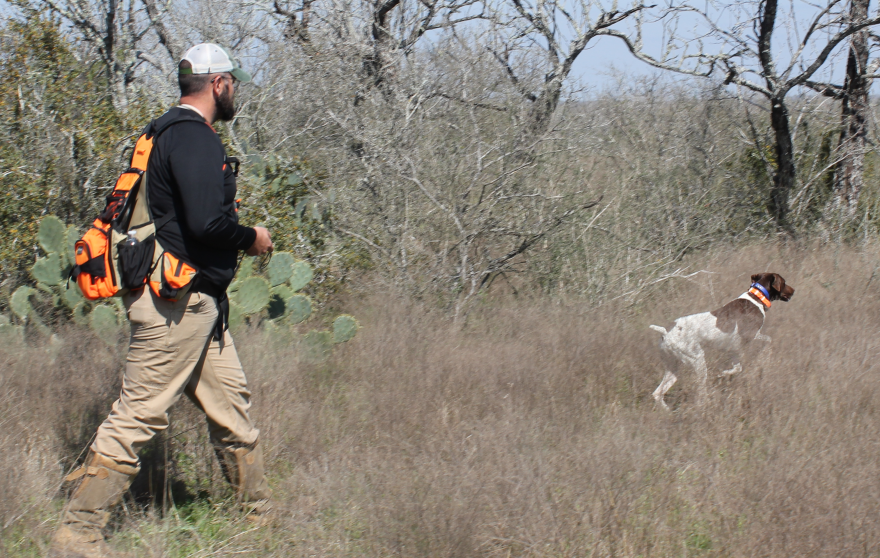With whistles and "whoops" Mark Lange is calling to and directing Ira one of his bird dogs. Ira is a brown and white German short haired pointer. She is happily romping through the tall South Texas grass searching for a covey of Bobwhite quail. But this is a different kind of bird hunt Lange is Texas Parks and Wildlife Biologist

“She a little close running dog and she won’t range out too far,” said Lange.
Ira is roaming this Karnes County ranch land, sniffing as she goes, until she finds something interesting. Then she holds her position. But this time it’s just a clump of quail feathers. On this day Ira doesn’t find any quail to flush out.
“You know what they say, finding quail get in way of a good walk,” said FratesSeeligson, He owns the five thousand acres called the Pajarito Ranch – which translates to “little bird.” He’s been transforming his land back into an area that will welcome back quail and other native birds that have been on the decline.

“Quail are huge to Texas. I mean quail are the quintessential upland bird from a sporting standpoint. The bobwhite quail – the gentleman quail - it’s important because of the heritage. It’s important because they can become an economic resource and they are an indicator species,” said Seeligson.
Quail were once plentiful in Texas but according to Texas Parks and Wildlife officials the population has fallen over 60 percent in the last 30 years and it continues to crash.
“When the quail decline there’s always another reason why they are declining – it’s not just – oh it’s been another bad year for the quail – let’s look at it – did the habitat change? They are an indicator just like a canary in the coal mine,” he said.

Trent Teinert a Texas Parks and Wildlife field biologist says a habitat problem for the quail is an invasive species of clump grass called Old World Blue Stem.
“It forms a dense matt – so if you can imagine you were a small quail trying to run through this area you’d have a difficult time,” said Teinert.
Matt Reidy – also a Texas Parks and Wildlife biologist says the quail would rather have a native blue stem grass.
“This bunch grass has a bunch of grass then you have space then you have other bunches of grass. And the grass itself, they're not going to eat it but they'll use that for cover and they'll nest in a clump like this,” said Reidy.

But a major challenge for the quail is traditional cattle ranching practices – those giant pastures of turf grass and coastal look like a desert for the quail. And Seeligson joined with his neighbor ranchers to form a co-op called the Post Oak quail group where they all are setting aside ranch land for quail – together they represent 20 thousand acres in Karnes and Wilson Counties with restored Texas savannah habitats Which also works out well for raising cattle.
"Cattle are in here. Cattle have been in here and cattle will keep coming back in here. There’s room for both, there really is," said Seeligson.

Also, If a rancher has quail on his land that can also become a money maker with the hunting community.
Recognizing that quail and 24 other grassland birds are in trouble and helping them is in the best interest of the state’s ecology and economy the state legislature ear marked $6 million dollars for research and programs to educate ranchers like Seeligson.
"Now we sit here on my porch and I can hear quail calling in the Springtime and calling covey calls in the Fall. And it's a nice sound," he said.



